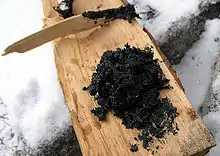Birch tar
Birch tar or birch pitch is a substance (liquid when heated) derived from the dry distillation of the bark of the birch tree.


Ancient and modern uses
Birch tar was used widely as an adhesive as early as the Middle Paleolithic to early Mesolithic era. Neanderthals produced tar through the dry distillation of birch bark as early as 200,000 years ago.[1] A study from 2019 showed that birch tar production can be a very simple process - merely involving the burning of birch bark near smooth vertical surfaces in open air conditions.[2] A rare find from the Dutch North Sea shows that Neanderthals used birch bark tar as a backing on small 'domestic' stone tools.[3]
Birch tar also has been used as a disinfectant, in leather dressing, and in medicine.
5,000-year-old chewing gum made from birch bark tar and still bearing tooth imprints, has been found in Kierikki in Finland.[4] Genetic material retained in the gum has enabled novel research regarding population movements, the types of foods consumed, and the types of bacteria found on their teeth.[5]
A different chewing gum sample, dated to 5,700 years old, was found in southern Denmark. A complete human genome and oral microbiome was sequenced from the chewed birch pitch. Researchers identified that the individual who chewed the pitch was a female closely related genetically to hunter-gatherers from mainland Europe.[6]
Ends of fletching of arrows were fastened with birch-tar and birch-tar-and-rawhide lashings were used to fix the blade of axes in the Mesolithic period.
Russia leather is a water-resistant leather, oiled with birch oil after tanning. This leather was a major export good from seventeenth and eighteenth century Russia, as the availability of birch oil limited its geographical production.[7] The oil impregnation also deterred insect attack and gave a distinctive and pleasant aroma that was seen as a mark of quality in leather.
Birch tar is also one of the components of Vishnevsky liniment.[8]
Birch tar oil is an effective repellent of gastropods.[9] The repellent effect lasts about two weeks.[9] The repellent effect of birch tar oil mixed with petroleum jelly applied to a fence lasts up to several months.[9]
Birch tar oil has strong antiseptic properties [10] owing to a large amount of phenol derivatives and terpenoid derivatives.
Birch tar oil also is used in perfumery as a base note to impart leather, tar, smoky, and wintergreen notes. It is used as an ingredient in some soaps, notably being the scent of Imperial Leather.
References
- Kozowyk, P. R. B.; Soressi, M.; Pomstra, D.; Langejans, G. H. J. (2017-08-31). "Experimental methods for the Palaeolithic dry distillation of birch bark: implications for the origin and development of Neandertal adhesive technology". Scientific Reports. 7 (1): 8033. doi:10.1038/s41598-017-08106-7. ISSN 2045-2322. PMC 5579016. PMID 28860591.
- Schmidt, P.; Blessing, M.; Rageot, M.; Iovita, R.; Pfleging, J.; Nickel, K. G.; Righetti, L. & Tennie, C. (2019). "Birch tar extraction does not prove Neanderthal behavioral complexity". PNAS. 116 (36): 17707–17711. doi:10.1073/pnas.1911137116. PMC 6731756. PMID 31427508.
- Niekus, Marcel J. L. Th.; Kozowyk, Paul R. B.; Langejans, Geeske H. J.; Ngan-Tillard, Dominique; van Keulen, Henk; van der Plicht, Johannes; Cohen, Kim M.; van Wingerden, Willy; van Os, Bertil; Smit, Bjørn I.; Amkreutz, Luc W. S. W. (2019-10-21). "Middle Paleolithic complex technology and a Neandertal tar-backed tool from the Dutch North Sea". Proceedings of the National Academy of Sciences. 116 (44): 22081–22087. doi:10.1073/pnas.1907828116. ISSN 0027-8424. PMC 6825292. PMID 31636186.
- "Student dig unearths ancient gum, 2007".
- Ancient gum DNA, Science, The New York Times, December 17, 2019
- Jensen, Theis Z. T.; Niemann, Jonas; Iversen, Katrine Højholt; Fotakis, Anna K.; Gopalakrishnan, Shyam; Vågene, Åshild J.; Pedersen, Mikkel Winther; Sinding, Mikkel-Holger S.; Ellegaard, Martin R.; Allentoft, Morten E.; Lanigan, Liam T. (2019-12-17). "A 5700 year-old human genome and oral microbiome from chewed birch pitch". Nature Communications. 10 (1): 1–10. doi:10.1038/s41467-019-13549-9. ISSN 2041-1723. PMC 6917805. PMID 31848342.
- "Production of Russia Leather" (PDF). The Honourable Cordwainers' Company. 1807. Archived from the original (PDF) on 2016-03-04. Retrieved 2013-10-04.
- Charman, C. (12 June 1999). "Vishnevsky liniment and ichthammol: on the perspectives of application in military medicine and other fields". The BMJ. 318 (7198): 1600–1604. doi:10.1136/bmj.318.7198.1600. PMC 1115970. PMID 10364122. Retrieved 5 July 2016.
- Lindqvist, I.; Lindqvist, B.; Tiilikkala, K.; Hagner, M.; Penttinen, O.-P.; Pasanen, T.; Setälä, H. (2010). "Birch tar oil is an effective mollusc repellent: field and laboratory experiments using Arianta arbustorum (Gastropoda: Helicidae) and Arion lusitanicus (Gastropoda: Arionidae)". Agricultural and Food Science. 19 (1): 1–12. doi:10.2137/145960610791015050.
- Wanamaker, L, "Birch Tar Oil A Powerful Antiseptic", OtzisPouch, 2020-04-01